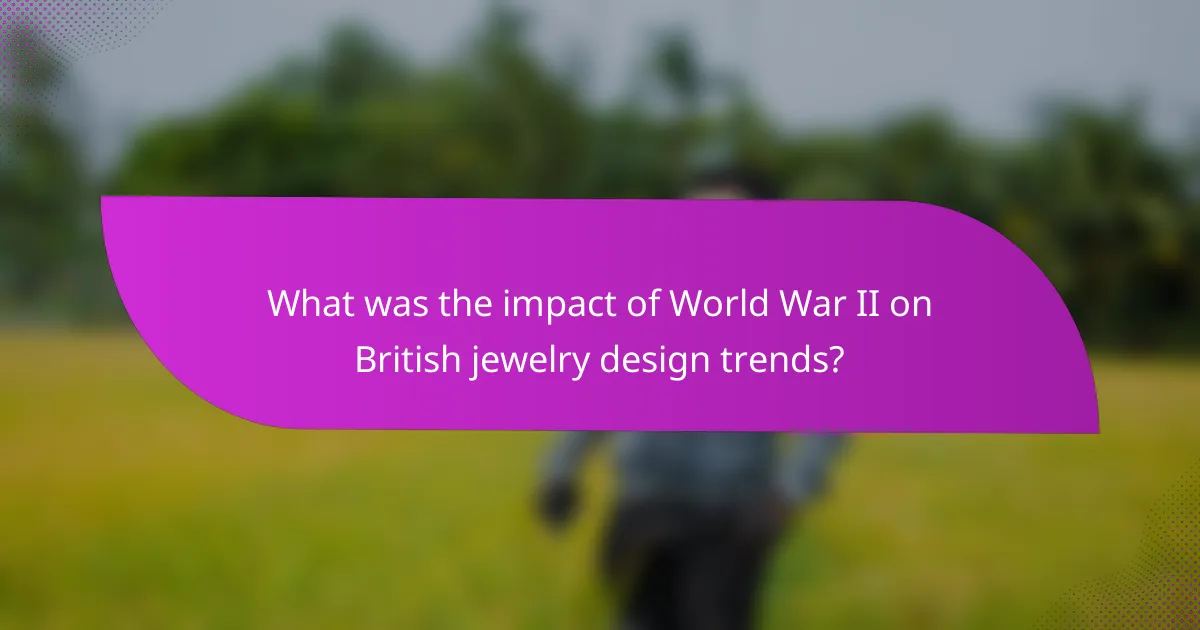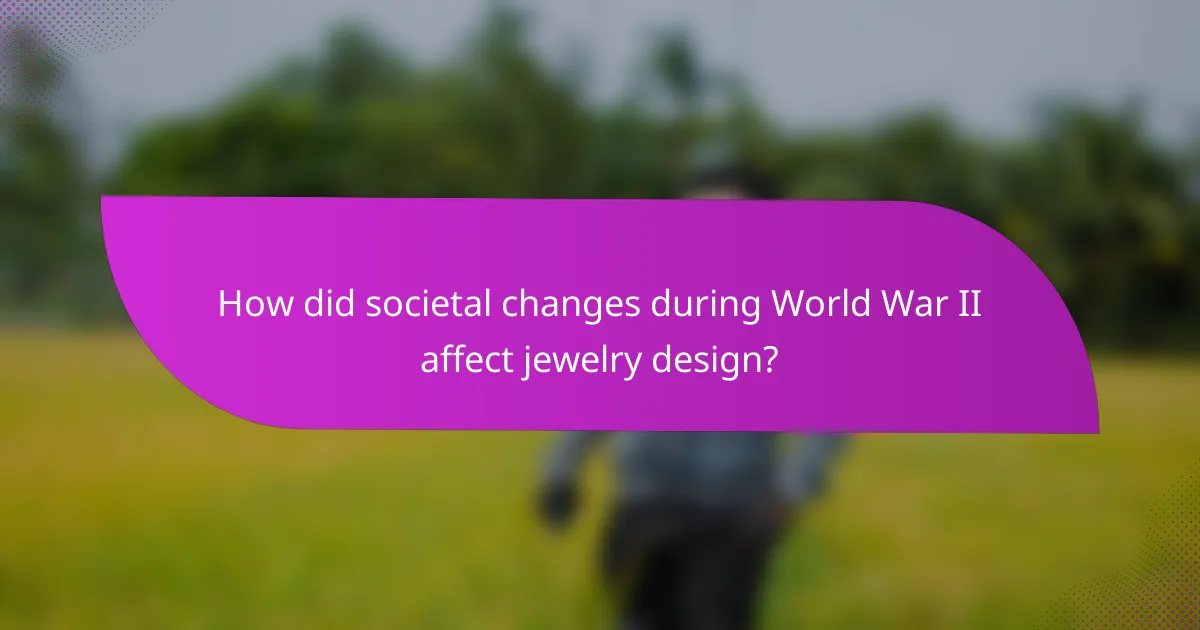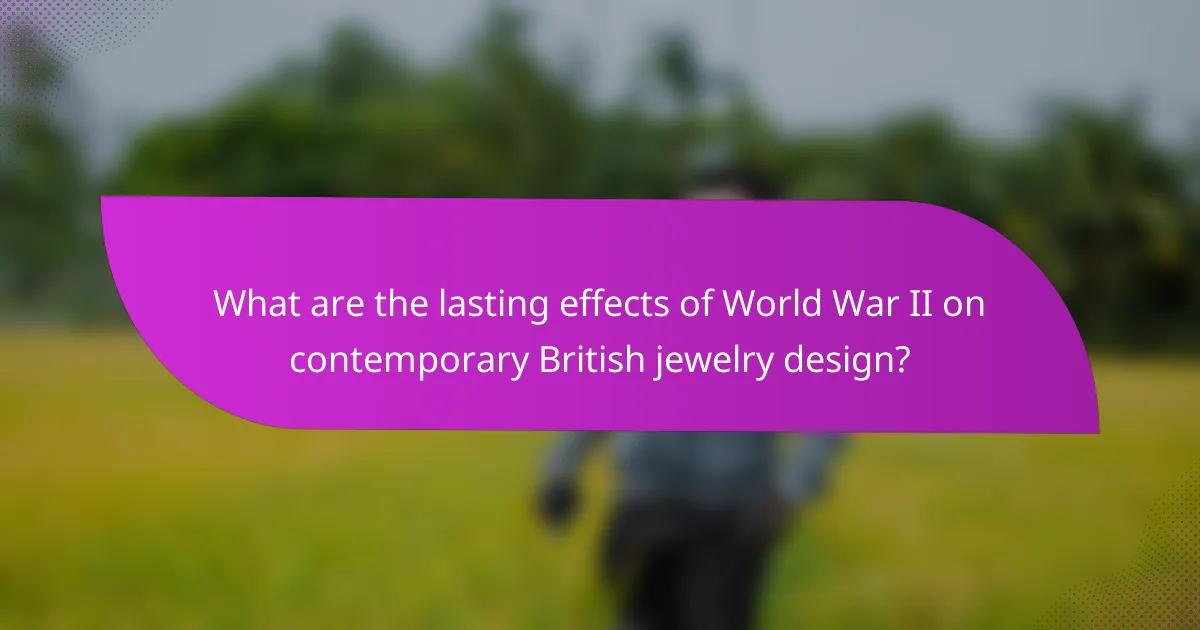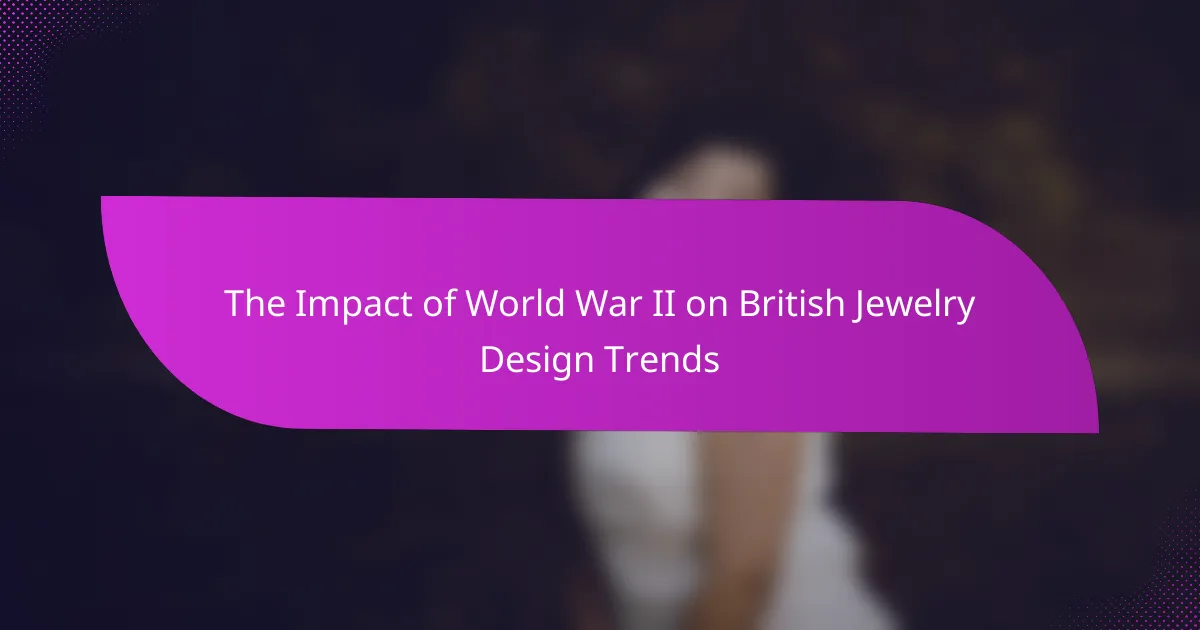World War II had a profound impact on British jewelry design trends, leading to significant shifts in materials and styles. Due to material shortages, jewelers turned to alternative materials such as plastic and base metals, resulting in simpler and more functional designs that reflected the wartime ethos of practicality. The emotional climate of the era also inspired patriotic themes and sentimental pieces, while post-war recovery saw a resurgence of opulence and craftsmanship. This evolution of British jewelry, influenced by both wartime necessity and changing societal roles, continues to shape contemporary design, blending modern and vintage elements.

What was the impact of World War II on British jewelry design trends?
World War II significantly influenced British jewelry design trends. The war led to material shortages, which prompted jewelers to innovate with alternative materials. Traditional precious metals and gemstones were often replaced with more accessible materials like plastic and base metals. This shift resulted in a more utilitarian approach to jewelry design. Designs became simpler and more functional, reflecting the wartime ethos of practicality. Additionally, patriotic themes emerged, with jewelry featuring national symbols. Post-war, there was a resurgence of opulence, as designers sought to celebrate peace and recovery. This duality of simplicity during the war and extravagance afterward shaped the evolution of British jewelry in the mid-20th century.
How did the war influence materials used in jewelry design?
The war significantly influenced materials used in jewelry design by restricting access to precious metals and gemstones. During World War II, rationing led to a scarcity of traditional materials. Jewelers adapted by using alternative materials such as base metals and synthetic stones. This shift was necessary due to wartime shortages and economic constraints. For example, aluminum and bakelite became popular substitutes. The use of these materials allowed for innovative designs that reflected the era’s resourcefulness. Additionally, the war inspired themes of patriotism and resilience in jewelry pieces. These adaptations ultimately shaped the future of jewelry design in Britain.
What alternative materials became popular during and after the war?
Alternative materials such as plastic, aluminum, and synthetic gemstones became popular during and after the war. Due to metal shortages, jewelers turned to plastic for affordability and versatility. Aluminum offered a lightweight option that was easy to work with. Synthetic gemstones provided a cost-effective alternative to natural stones. These materials allowed for innovative designs that reflected the resource constraints of the time. The shift to alternative materials marked a significant change in jewelry trends in post-war Britain.
How did rationing affect the choice of gemstones and metals?
Rationing during World War II significantly impacted the choice of gemstones and metals. Jewelers faced restrictions on the availability of precious materials. This led to a preference for alternative, less expensive gemstones. Semi-precious stones became more popular due to their accessibility. Additionally, metals like gold and platinum were rationed, prompting the use of silver and base metals. The scarcity of resources influenced design aesthetics, resulting in simpler, more practical jewelry. These changes reflected the economic realities of the time. Historical records indicate that many jewelers adapted by creating innovative designs with available materials.
What changes occurred in jewelry styles during World War II?
Jewelry styles during World War II shifted significantly due to material shortages and changing societal roles. Traditional luxury materials like gold and diamonds became scarce. Jewelers adapted by using alternative materials such as silver, base metals, and even plastic. Designs became simpler and more utilitarian, reflecting wartime practicality. The influence of military aesthetics emerged, with designs featuring patriotic symbols. Costume jewelry gained popularity as an affordable option for the masses. Women’s increased participation in the workforce also influenced jewelry styles, leading to more versatile and functional pieces. These changes collectively marked a departure from pre-war opulence to a focus on practicality and modesty.
How did wartime aesthetics reshape design elements?
Wartime aesthetics reshaped design elements by emphasizing functionality and simplicity. During World War II, materials were scarce. This scarcity led designers to prioritize practicality over ornamentation. Jewelry became more utilitarian, focusing on durability and ease of wear. Designs featured geometric shapes and minimalistic forms. Additionally, patriotic themes emerged in jewelry, reflecting national pride. Enamel and metal were commonly used due to material restrictions. The influence of military uniforms also inspired color palettes and textures in designs. Overall, wartime aesthetics instilled a sense of resilience and resourcefulness in British jewelry design.
What specific jewelry styles emerged as a result of the war?
Art Deco and Retro jewelry styles emerged as a result of World War II. Art Deco featured geometric designs and bold colors, reflecting the optimism of the era. Retro jewelry embraced larger, more flamboyant pieces, often using gold and vibrant gemstones. Both styles were influenced by the materials and manufacturing techniques available during and after the war. The scarcity of certain materials led to innovative uses of alternative metals and synthetic stones. Additionally, wartime rationing affected design choices, pushing jewelers to create more practical and versatile pieces. This period marked a significant shift in aesthetics, moving towards more expressive and personalized jewelry.

How did societal changes during World War II affect jewelry design?
Societal changes during World War II significantly influenced jewelry design. The war led to material shortages, prompting designers to use alternative materials. Precious metals became scarce, leading to the use of base metals and synthetic stones. Jewelry design shifted towards simpler, more practical styles. This reflected the need for functionality over extravagance. Additionally, wartime propaganda promoted patriotic themes in jewelry. Designs often incorporated national symbols or colors. The emotional climate of the era also inspired sentimental pieces. Overall, jewelry became a means of expression during a time of uncertainty.
What role did women play in jewelry design during the war?
Women played a significant role in jewelry design during the war. Many women entered the workforce to fill gaps left by men who went to fight. They contributed to the design and production of jewelry, often using innovative materials due to resource shortages. Women designers created pieces that reflected wartime themes, incorporating symbols of hope and resilience. The war also led to the rise of costume jewelry, which women designed to be affordable and accessible. This shift allowed for greater creativity and expression in jewelry design. Women’s contributions during this period helped redefine the industry and paved the way for future female designers.
How did the workforce shift influence design trends?
The workforce shift during World War II significantly influenced design trends in British jewelry. As men left for military service, women entered the workforce in larger numbers. This change led to the emergence of more practical and functional designs. Jewelry became simpler, emphasizing utility over extravagance. The materials used also shifted due to rationing, favoring less expensive options. Designs often incorporated patriotic themes and symbols of resilience. The influence of wartime production needs created a focus on mass production techniques. This resulted in accessible jewelry that appealed to a broader audience. Overall, the workforce shift reshaped the aesthetic and functional aspects of British jewelry design during this period.
What were the notable contributions of female designers during this period?
Female designers made significant contributions to British jewelry design during World War II. They introduced innovative designs that reflected the resilience and spirit of the era. Many female designers utilized materials that were more readily available due to wartime restrictions. This included the use of plastic and synthetic stones, which were creatively incorporated into their pieces.
Notable figures such as Elizabeth Gage and Vivienne Becker emerged during this period. They challenged traditional notions of jewelry by creating bold, statement pieces. Their work often featured motifs inspired by nature and symbolism, resonating with the emotional landscape of wartime Britain.
The contributions of these female designers played a crucial role in shaping new trends in jewelry design. Their influence can still be seen in contemporary jewelry, showcasing their lasting impact on the industry.
How did cultural influences shape jewelry trends in post-war Britain?
Cultural influences significantly shaped jewelry trends in post-war Britain. The aftermath of World War II brought a desire for optimism and renewal. This was reflected in jewelry designs that featured bright colors and bold geometric shapes. The influence of modernism emerged as artists sought to break away from traditional styles. Additionally, the rise of popular culture, including films and music, inspired jewelry trends. Iconic figures, such as movie stars, set trends that the public eagerly followed. The use of new materials, like plastics and synthetic stones, became prevalent during this period. Economic factors also played a role, as people sought affordable yet stylish jewelry. These cultural shifts collectively transformed the landscape of jewelry design in post-war Britain.
What international styles were adopted in British jewelry design after the war?
British jewelry design adopted several international styles after the war. These styles included Art Deco, which emphasized geometric shapes and bold colors. Additionally, the influence of Scandinavian design became prominent, showcasing minimalism and functional aesthetics. The revival of antique styles, particularly Victorian and Edwardian, also occurred during this period. Furthermore, Eastern influences, particularly from India and Japan, were integrated into British designs. These shifts reflected broader cultural exchanges and changing tastes in post-war society.
How did British jewelry reflect the mood of post-war society?
British jewelry in the post-war society reflected a sense of optimism and resilience. The designs incorporated simpler, more practical styles. This shift was a response to the economic constraints of the time. Jewelry became more accessible to the general public. The use of materials like silver and semi-precious stones increased. These choices symbolized a departure from luxury and excess. The influence of modernism was evident in geometric shapes and clean lines. Overall, British jewelry mirrored the collective desire for renewal and hope after the war.

What are the lasting effects of World War II on contemporary British jewelry design?
World War II has significantly influenced contemporary British jewelry design. The war led to material shortages, prompting designers to innovate with alternative materials. This period saw the rise of costume jewelry, which became popular due to the scarcity of precious metals. Additionally, the emotional and cultural impact of the war inspired themes of resilience and patriotism in jewelry designs.
Post-war, there was a focus on craftsmanship and handmade pieces, reflecting a return to traditional techniques. The influence of military aesthetics and utilitarian designs can still be observed in modern collections. Iconic British designers, such as Vivienne Westwood, incorporate historical references into their work, showcasing the lasting legacy of the era.
Moreover, the war’s impact on women’s roles contributed to a shift in consumer preferences, leading to more bold and expressive jewelry styles. The fusion of modern and vintage elements continues to define contemporary British jewelry today.
How can we see the influences of World War II in modern jewelry trends?
World War II has significantly influenced modern jewelry trends through its emphasis on practicality and symbolism. During the war, materials were scarce, leading to the use of alternative materials like plastic and base metals. This trend continues today, as designers incorporate non-traditional materials into their pieces.
Additionally, wartime jewelry often featured patriotic symbols and motifs. Modern jewelry frequently reflects similar themes of national pride and resilience. The use of bold designs and geometric shapes in jewelry can also be traced back to the Art Deco movement, which gained momentum during the war era.
Furthermore, the sentiment of remembrance in jewelry has roots in the wartime practice of creating pieces to honor lost loved ones. This has evolved into contemporary memorial jewelry, which serves as a personal tribute. Overall, the legacy of World War II is evident in the blend of practicality, symbolism, and innovative materials that characterize current jewelry trends.
What design elements from the WWII era persist in today’s jewelry?
Design elements from the WWII era that persist in today’s jewelry include bold geometric shapes and military-inspired motifs. These elements reflect the utilitarian aesthetic that was prominent during the war. Jewelry designers today often incorporate angular designs and streamlined forms reminiscent of wartime industrial influences. Additionally, the use of patriotic symbols, such as stars and stripes, can still be seen in contemporary pieces. The color palette of military greens, muted earth tones, and metallic finishes also remains popular. This connection to history adds a layer of meaning to modern jewelry, appealing to consumers’ desire for nostalgia and heritage. The enduring influence of WWII design is evident in both high fashion and everyday jewelry collections.
How do contemporary designers pay homage to wartime influences?
Contemporary designers pay homage to wartime influences by incorporating historical motifs and materials. They often draw inspiration from the aesthetics of World War II, such as utilitarian designs and military insignia. Designers may use vintage materials like repurposed metals and fabrics reminiscent of wartime rationing. Additionally, they create pieces that reflect the resilience and spirit of the era, often featuring bold and functional elements. The use of symbolism, such as peace signs or remembrance themes, is also prevalent. This approach connects modern jewelry to its historical context, celebrating the past while appealing to contemporary sensibilities.
What lessons can current designers learn from WWII jewelry trends?
Current designers can learn the importance of resourcefulness from WWII jewelry trends. During the war, materials were scarce, prompting designers to innovate with alternative materials. Jewelry was often made from less expensive metals and synthetic stones. This adaptability led to unique designs that reflected the era’s challenges. Additionally, the use of patriotic themes in jewelry can inspire modern designers to incorporate cultural significance into their work. The trend of creating meaningful pieces that resonate with societal issues is still relevant today. Lastly, the emphasis on craftsmanship during WWII highlights the value of quality and durability in jewelry design. These lessons can guide contemporary designers in creating impactful and resilient pieces.
How can historical context inform modern jewelry design practices?
Historical context can significantly inform modern jewelry design practices by providing insights into cultural values and aesthetics. Designers often draw inspiration from past movements and events, like World War II. During this period, jewelry was influenced by resource scarcity and changing social roles. For example, women began to wear more practical and versatile pieces as they entered the workforce. This shift led to the development of designs that emphasized functionality alongside beauty.
Additionally, historical context reveals the symbolism behind materials and styles. Post-war jewelry often featured motifs of resilience and hope, reflecting the societal mood. Designers today can incorporate these themes to evoke emotional connections in their work.
Moreover, understanding historical techniques and craftsmanship can enhance modern practices. Techniques used in the past, such as hand engraving or enameling, can be revisited and adapted to contemporary designs. By examining historical context, modern jewelry designers can create pieces that resonate with both tradition and innovation, bridging the past with the present.
What best practices can be derived from the evolution of jewelry during the war?
Best practices derived from the evolution of jewelry during the war include adaptability in design and materials. Jewelry designers adapted to shortages by using alternative materials like plastic and aluminum. They also embraced simpler forms and designs due to resource constraints. The war led to the rise of sentimental jewelry, emphasizing personal meaning over luxury. Designers focused on creating pieces that were affordable and accessible. Post-war, the emphasis on sustainability emerged, influencing modern jewelry practices. Historical examples include the use of recycled materials in wartime pieces. These practices highlight the importance of innovation and consumer connection in jewelry design.
The main entity of the article is British jewelry design trends influenced by World War II. The article examines how wartime material shortages led to innovative use of alternative materials, resulting in simpler, more functional designs that reflected the practicality of the era. It discusses the emergence of patriotic themes, the role of women in jewelry design, and the shift towards accessible costume jewelry. Additionally, the article highlights the lasting effects of these changes on contemporary jewelry design, including the incorporation of historical motifs and resourcefulness in modern practices.
